
As more wealth is created in the world, more of it is concentrated among the richest people in the richest countries. The combined gross domestic product of countries for which there is data adds up to $116.7 trillion. Nearly $93 trillion of that wealth is concentrated among just 25 countries.
GDP may be the standard method for gauging the size of a particular country or region’s economy, but it does not account for all of the wealth generated by that nation. A more accurate indicator of a country’s economic output is its gross national income, or GNI. This measure captures all economic activity within a nation’s borders in addition to the wealth created by nationally-owned entities operating in other countries.
Using data from the World Bank, 24/7 Wall St. reviewed the GNI per capita of nearly 200 nations to identify the 25 richest countries. We also included life expectancy at birth from the World Bank.
The wealthiest 25 countries in the world tend to have complex and diverse economies. Many of these countries export goods and services from a variety of industries such as pharmaceuticals, biotechnology, and aerospace.
Yet some nations on this list rely almost exclusively on one product to fuel their economies. Some smaller countries that do not have a wide variety of industries still rank among the wealthiest nations in the world because they are among the countries that controls the world’s oil.
The wealthiest countries also tend to be the healthiest. The world average life expectancy at birth is 72.2 years, yet in each of the world’s 25 richest countries, the average life expectancy is at least several years, if not a full decade, longer. Some of the richest nations also rank among the healthiest countries in the world.
Click here to see the richest countries in the world
Click here to read our methodology

25. France
> GNI per capita: $39,784
> 2017 GDP: $2.6 trillion (10th out of 196 countries)
> Population: 67.1 million
> Life expectancy at birth: 82.5 years
With a gross domestic product of more than $2.6 trillion in 2017, France is one of the wealthiest countries in the world. The French created nearly $40,000 in economic output per person in 2017. Like many other very wealthy nations, France’s economy is complex and diverse, exporting over $500 billion worth of goods and services annually. The country’s exports in 2017 included aerospace and automobile parts, medications, and more than $10 billion worth of wine.
Wealthy countries can afford to invest in health care infrastructure, and their residents can afford to lead healthier lives. As a result, the wealthiest nations tend to have the best health outcomes in the world. France’s life expectancy at birth of 82.5 years is more than a decade higher than the average life expectancy worldwide.
[in-text-ad]

24. Finland
> GNI per capita: $41,509
> 2017 GDP: $225.9 billion (61st out of 196 countries)
> Population: 5.5 million
> Life expectancy at birth: 81.4 years
Finland is one of just two dozen countries in the world where GNI per capita was over $40,000 in 2017. Finland has one of the most diverse export economies in the world, selling paper goods, refined petroleum, and various machinery around the world.
Finland’s relative prosperity is more evenly distributed among its residents. Likely in part due to the relative equality of the society, the Nordic country’s poverty rate is the lowest among all countries for which there is data. The country also has some of the best health outcomes as measured by life expectancy, maternal mortality, and infant mortality.
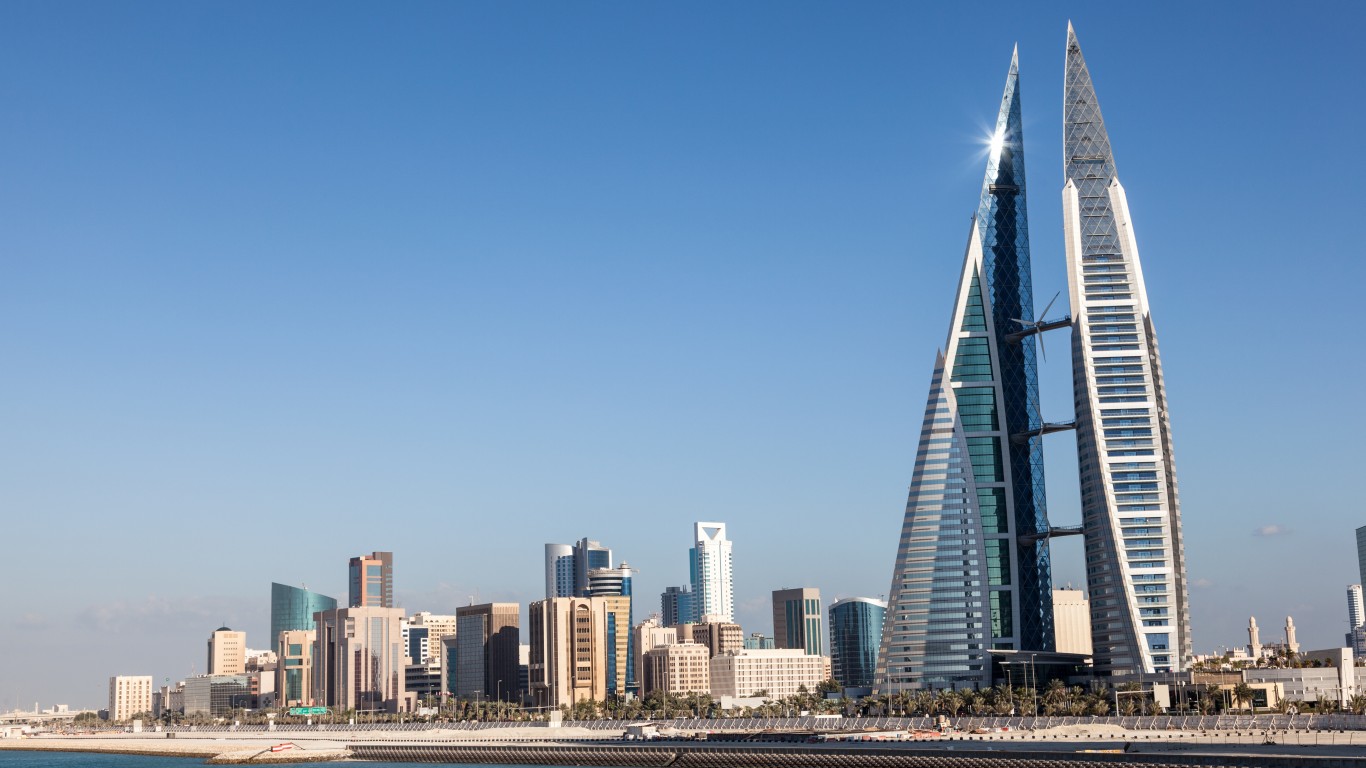
23. Bahrain
> GNI per capita: $41,557
> 2017 GDP: $64.7 billion (100th out of 196 countries)
> Population: 1.5 million
> Life expectancy at birth: 77.0 years
Bahrain’s high gross national income per capita of $41,557 is bolstered by the country’s very low unemployment rate. Less than 1% of the labor force in Bahrain is out of a job — the second lowest unemployment rate of any country on this list. The country relies heavily on natural resources, particularly petroleum. Of the nation’s exports in 2017, 38% came from refined petroleum. Iron ore and aluminum exports accounted for another 5.6%.
Bahrain’s population is growing faster than any other country on this list, ranking second in the world with an annual population growth of 4.6%, more than four times the rate of the world’s annual population growth.
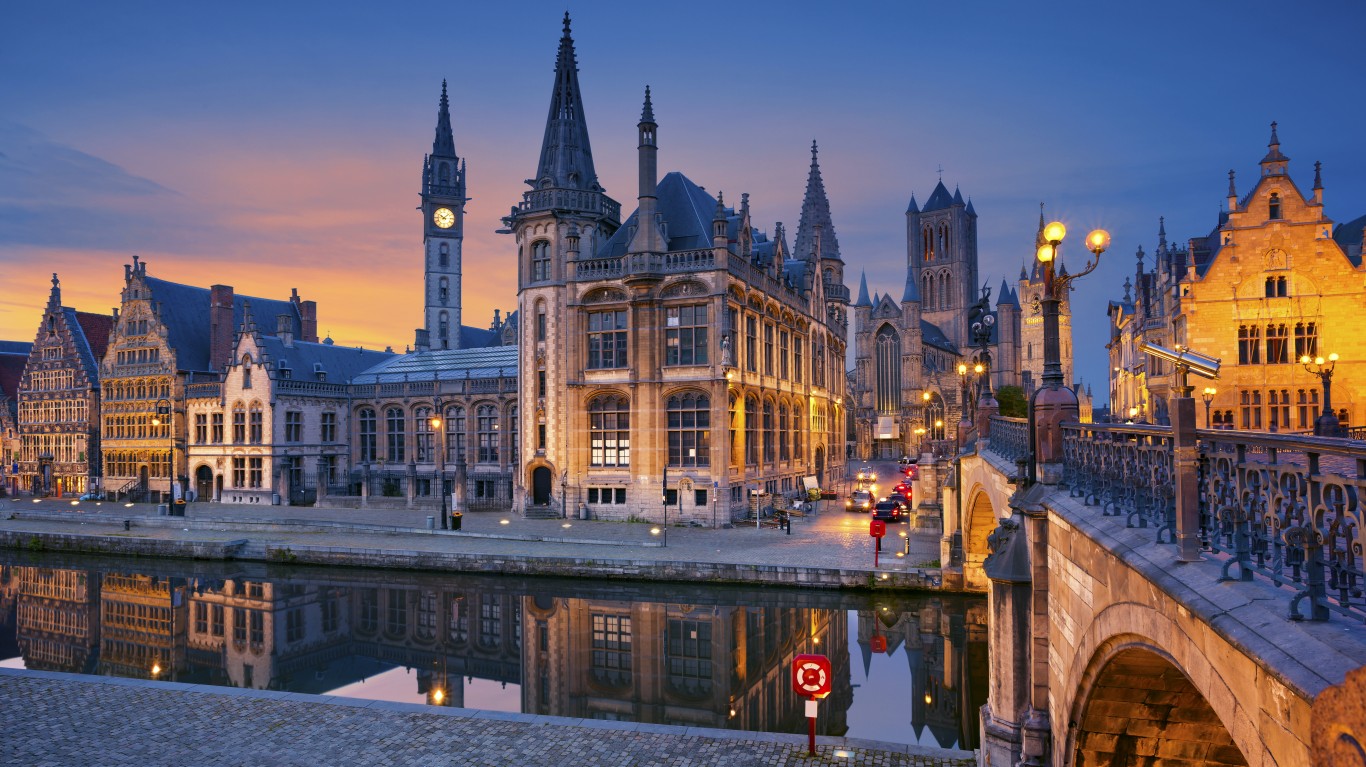
22. Belgium
> GNI per capita: $43,260
> 2017 GDP: $486.5 billion (38th out of 196 countries)
> Population: 11.4 million
> Life expectancy at birth: 81.4 years
Belgium leans heavily on exports to keep its economy running. The country’s exports of goods and services accounted for more than 85% of GDP. Worldwide, exports account for less than 30% of total GDP. Belgium primary exports include medicine, cars, refined petroleum, and diamonds.
To stay on the cutting edge of the products it manufactures and sells, research and development expenditure accounts for nearly 2.5% of Belgium’s GDP, one of the highest shares of any country in the world.
[in-text-ad-2]

21. Australia
> GNI per capita: $43,555
> 2017 GDP: $1.1 trillion (20th out of 196 countries)
> Population: 24.6 million
> Life expectancy at birth: 82.5 years
Australia is one of just 23 countries with a GDP of more than $1 trillion. Australia relies heavily on exports of natural resources — particularly iron ore. It is the world’s leading exporter of the mineral, accounting for 52% of the world’s total supply. This pumps tens of billions of dollars into the national economy, accounting for one-fifth of Australia’s total exports.
This relative affluence allows Australians to live relatively long, healthy lives. Only a handful of countries have a longer average life expectancy at birth than Australia’s 82.5 years.

20. Canada
> GNI per capita: $43,559
> 2017 GDP: $1.6 trillion (15th out of 196 countries)
> Population: 36.7 million
> Life expectancy at birth: 82.5 years
With a GDP exceeding $1.6 trillion, Canada is one of the wealthiest and most economically productive countries in the world. Canada is the world’s fourth largest exporter of crude petroleum, behind Saudi Arabia, Russia, and Iraq. In 2017 crude petroleum, accounting for 14% of Canada’s total export value.
This relative prosperity has helped make Canada a desirable destination for immigrants. Though Canada has the world’s 38th largest population with 36.7 million residents, it had the fourth highest net migration total in 2017, with a total of 1.1 million new residents.
[in-text-ad]

19. Austria
> GNI per capita: $45,375
> 2017 GDP: $400.2 billion (45th out of 196 countries)
> Population: 8.8 million
> Life expectancy at birth: 81.6 years
Austria was the 30th largest exporter in the world in 2017, despite being just the 96th largest country in terms of population. Machines and transportation vehicles accounted for much of the country’s exports worth.
Austria encourages innovation to bolster its economy. Like several other countries that rank among the richest in the world, research and development accounts for a significant percentage of Austria’s GDP. Austria is one of just six countries in which research and development spending is equal to more than 3% of GDP.
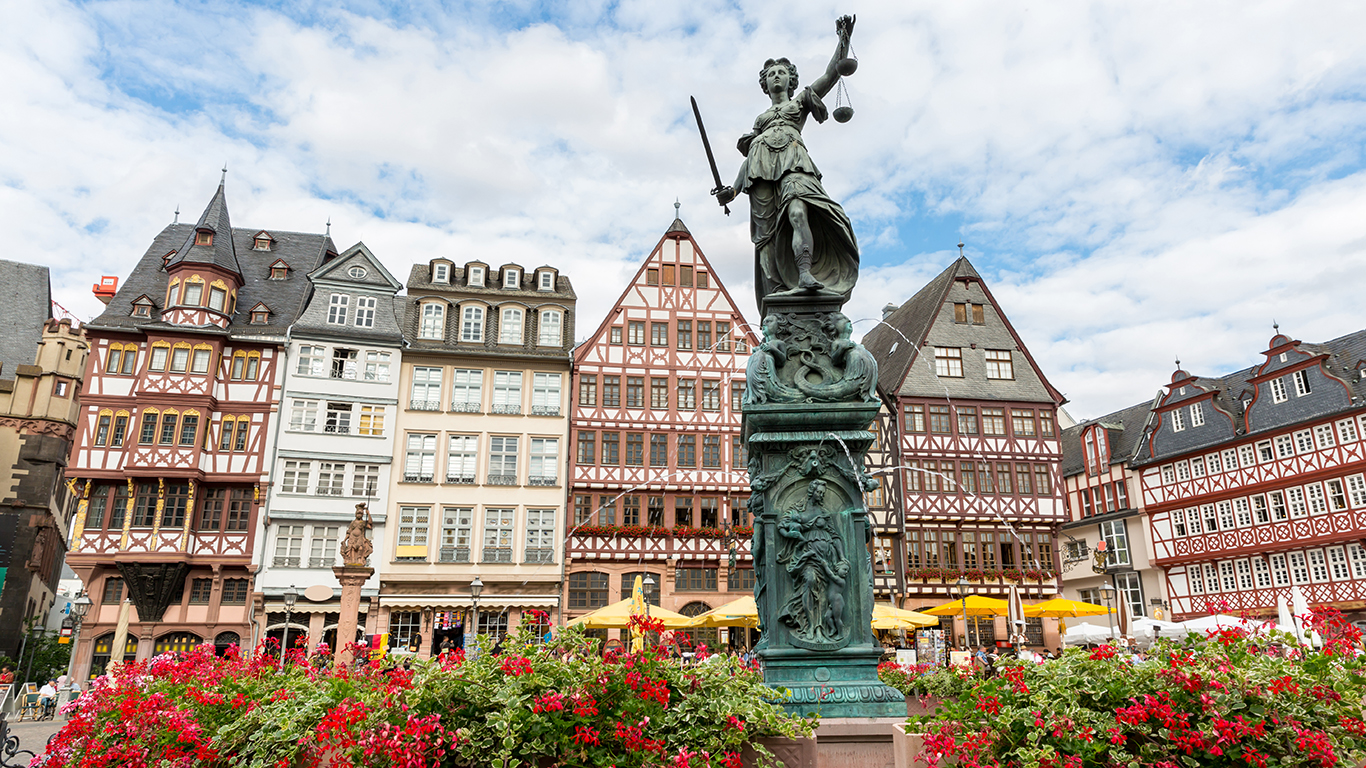
18. Germany
> GNI per capita: $46,422
> 2017 GDP: $3.8 trillion (5th out of 196 countries)
> Population: 82.7 million
> Life expectancy at birth: 81.0 years
Germany has one of the largest economies in the world, with a GDP of nearly $3.8 trillion. Germany ranked as the third largest exporter in the world in 2017 after China and the U.S., exporting more than $1.7 trillion worth of goods that year.
Though Germany exports a wide array of goods, automobiles are the main industry, accounting for 12% of all German exports in 2017. Germany is well known for its automotive prowess. German auto manufacturers BMW, Mercedes-Benz, Audi, and Volkwagen are some of the best known car brands in the world.
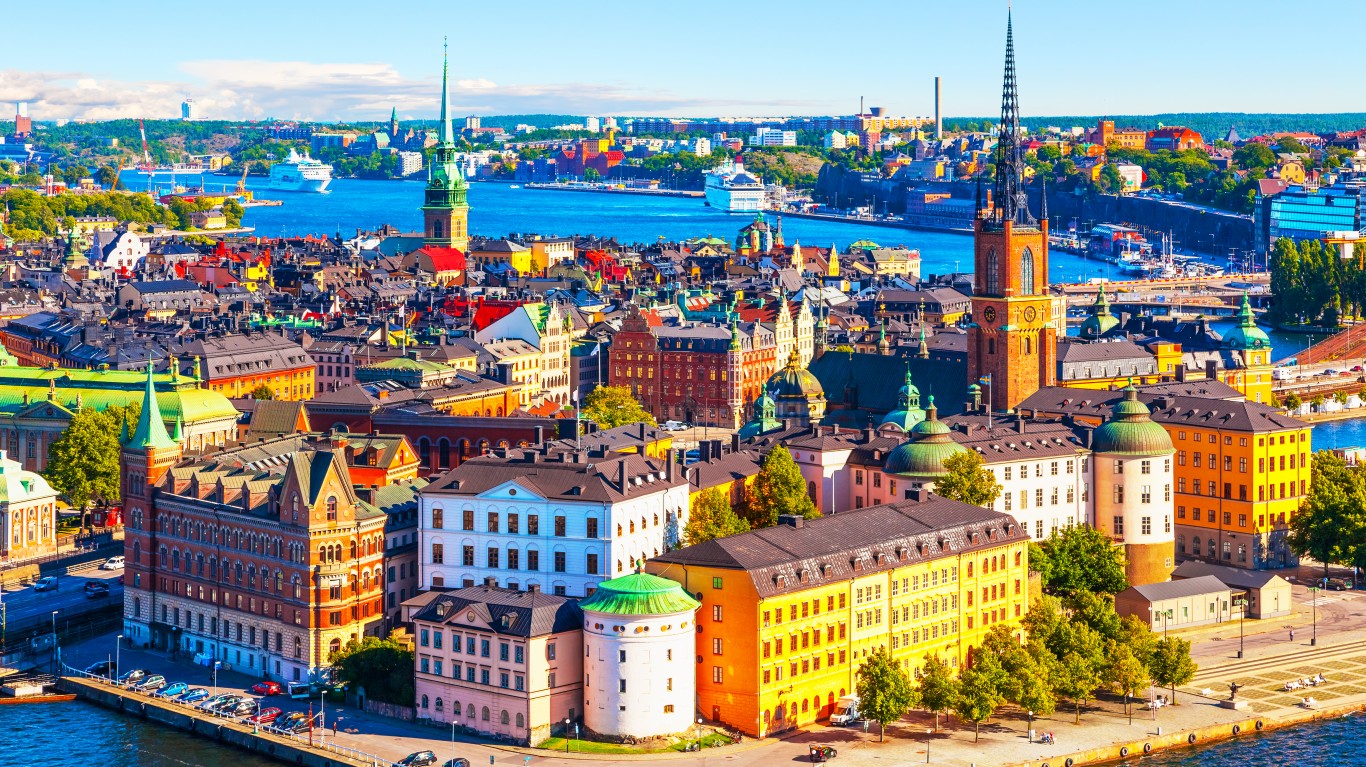
17. Sweden
> GNI per capita: $47,346
> 2017 GDP: $469.5 billion (40th out of 196 countries)
> Population: 10.1 million
> Life expectancy at birth: 82.3 years
Sweden invests more on education as a share of its GDP than almost any other country in the world. The country spends the equivalent of 7.6% of its GDP on education. This investment in education appears to be paying off as Sweden has among the highest primary school enrollment rates and primary school completion rates, setting its young residents up to be well educated and productive members of the economy in the future.
The Swedish economy is also driven by innovation. Research and development spending is equal to nearly 3.3% of Sweden’s GDP, the fourth highest share of any country in the world.
[in-text-ad-2]

16. Denmark
> GNI per capita: $48,260
> 2017 GDP: $272.5 billion (55th out of 196 countries)
> Population: 5.8 million
> Life expectancy at birth: 81.0 years
Denmark has one of the highest GNIs per capita, at more than $48,000. The country has a diverse economy, exporting billions of dollars worth of machines, chemical products, animal products, and other foodstuffs. Packaged medicaments make up the largest segment of Denmark’s exports.
The wealth in Denmark tends to be distributed relatively evenly among people as measured by the Gini coefficient. Denmark has one of the lowest Gini coefficients in the world. Likely contributing to the high level of equality is Denmark’s rank as the least corrupt country in the world, according to the 2018 Corruption Perceptions Index.
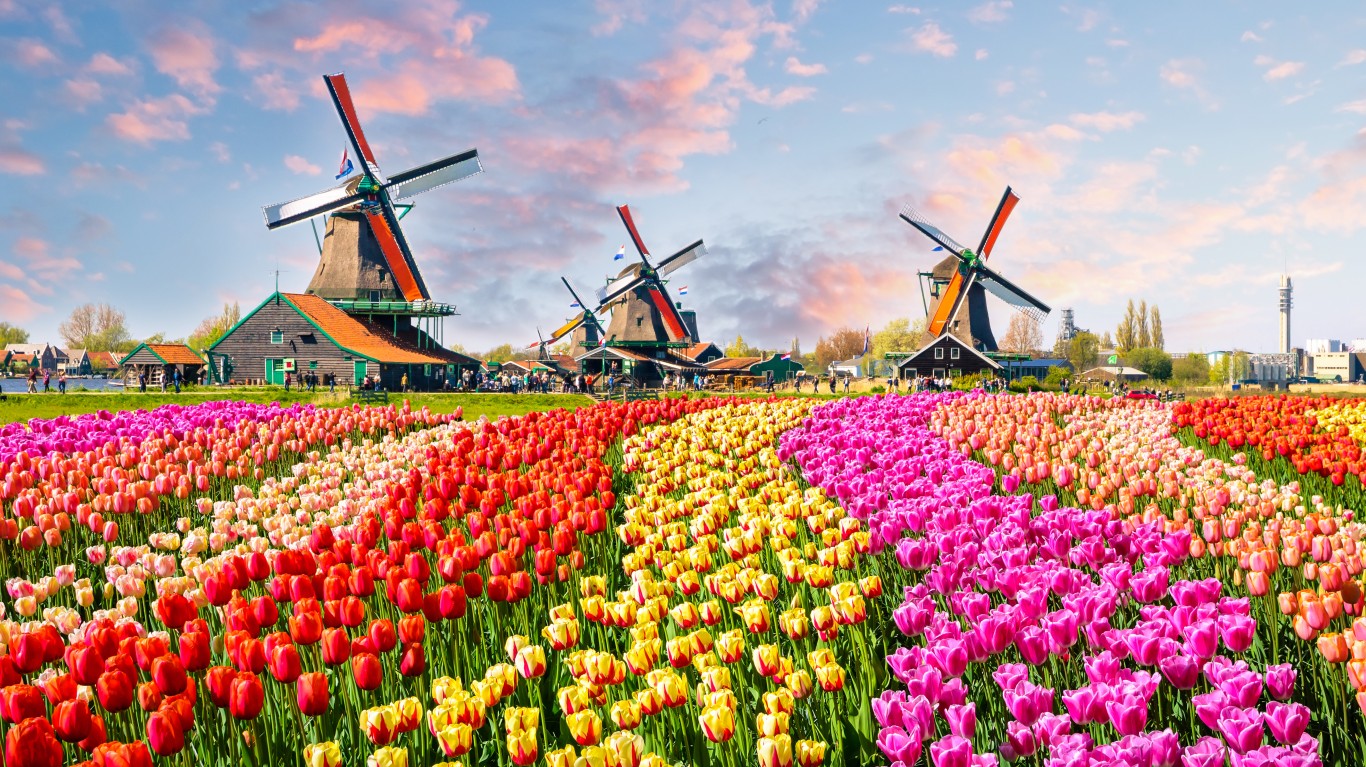
15. Netherlands
> GNI per capita: $48,994
> 2017 GDP: $835.8 billion (27th out of 196 countries)
> Population: 17.1 million
> Life expectancy at birth: 81.6 years
One of the richest countries in the world, the Netherlands’ GNI per capita is nearly $49,000. The country’s economy relies heavily on exports. In 2017, the country’s exports generated the equivalent of nearly 83% of the nation’s GDP — more than double the rate of the average country.
With an average life expectancy of 81.6 years at birth, the Netherlands has among the best health outcomes in the world. It also ranks better than most countries in terms of infant and maternal mortality.
[in-text-ad]
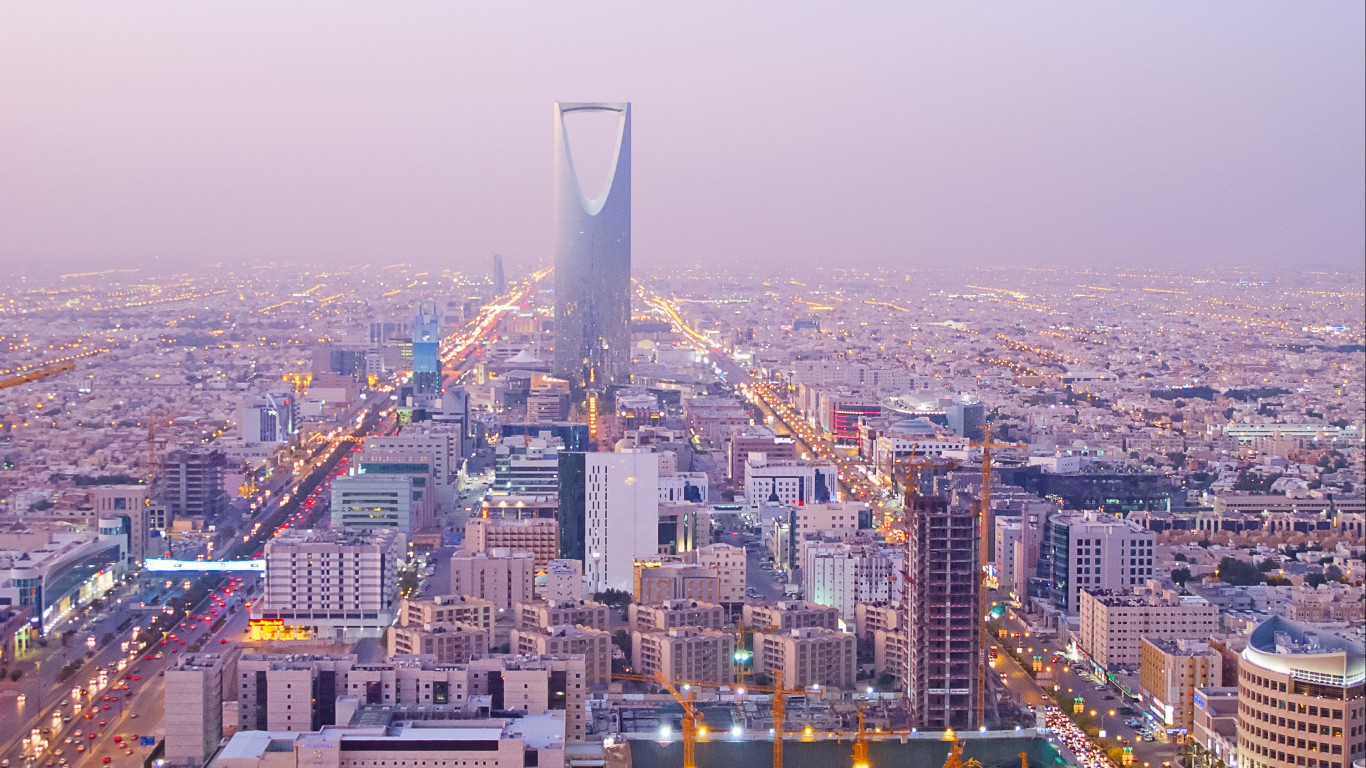
14. Saudi Arabia
> GNI per capita: $49,626
> 2017 GDP: $1.6 trillion (16th out of 196 countries)
> Population: 32.9 million
> Life expectancy at birth: 74.7 years
Saudi Arabia ranks among the richest countries in the world for one reason — oil. In the resource-rich kingdom, petroleum accounted for more than three-quarters of exports in 2017. No country exports more crude petroleum than Saudi Arabia.
While petroleum is lucrative, without a diversified economy, Saudi Arabia is vulnerable to fluctuations in oil prices. It is one of just two countries to rank among the richest in the world that also saw a decline in its GDP over the past year. The other, Kuwait, also relies heavily on petroleum. Saudi Arabia’s economy contracted by nearly 0.9% in 2017.

13. Ireland
> GNI per capita: $52,755
> 2017 GDP: $320.2 billion (50th out of 196 countries)
> Population: 4.8 million
> Life expectancy at birth: 82.0 years
Ireland is one of just 13 countries in which the GNI per capita exceeded $50,000 in 2017. The country also has one of the fastest growing economies, with a 7.2% annual increase in its GDP. Worldwide, the annual GDP increase was less than 3.2%.
Ireland relies heavily on exports. Ireland’s top exports are chemicals, like packaged medicaments. Its exports are actually worth more than its GDP, which is the case in only seven other countries. Ireland’s exports are worth nearly 20% more than its GDP of over $320 billion.

12. United States
> GNI per capita: $55,351
> 2017 GDP: $17.7 trillion (2nd out of 196 countries)
> Population: 325.1 million
> Life expectancy at birth: 78.5 years
One of the wealthiest nations in the world, the United States has a GNI per capita of more than $55,000. With such relative prosperity, the United States has been an attractive destination for immigrants, and the U.S. reported net migration of 4.5 million people in 2017, the highest total of any nation in the world.
Unlike nearly every other nation to rank among the richest in the world, the United States does not rely heavily on exports. The total export value of goods and services from the United States is equal to just 12.1% of GDP, the lowest share on this list and one of the lowest in the world. For context, exports are equal to an average of 29.4% of GDP globally. Among the 25 richest countries for which there is data, the United States also has the highest level of income inequality.
[in-text-ad-2]
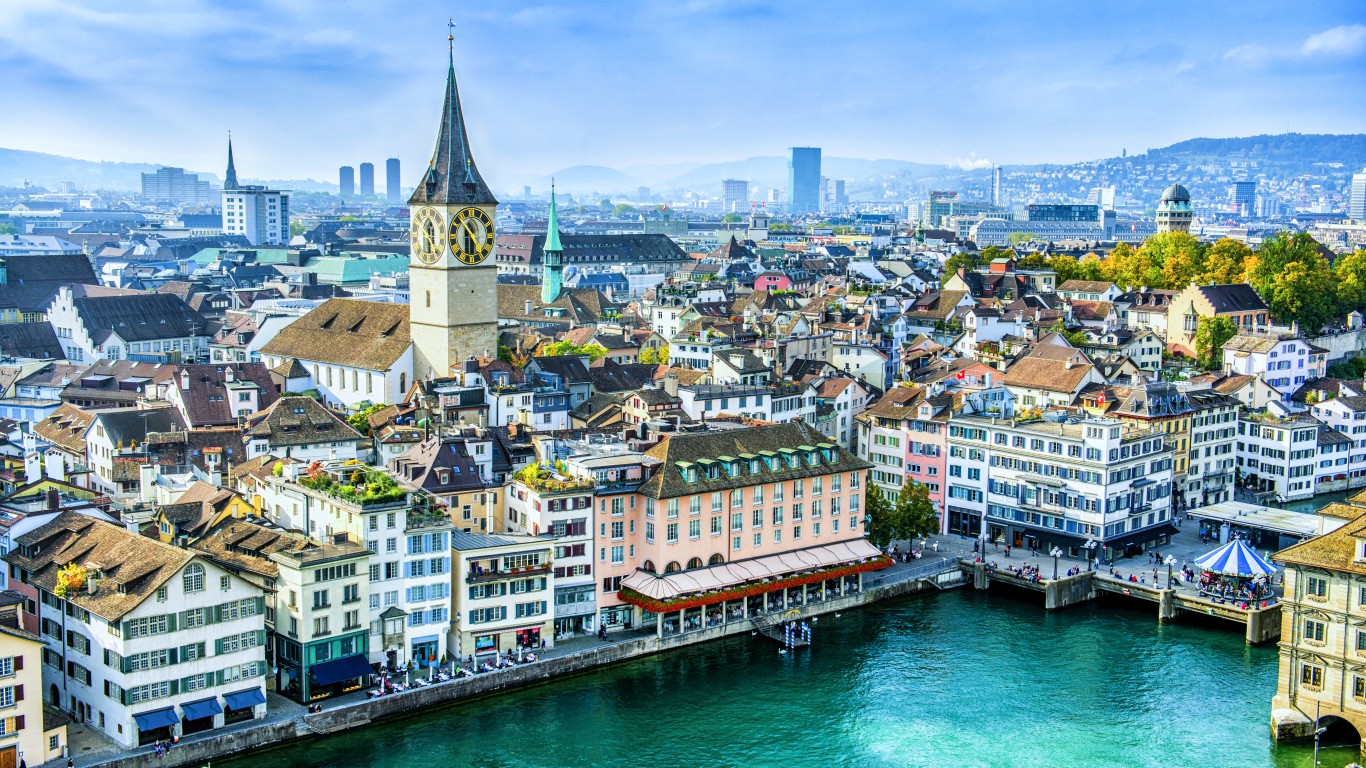
11. Switzerland
> GNI per capita: $58,138
> 2017 GDP: $490.2 billion (37th out of 196 countries)
> Population: 8.5 million
> Life expectancy at birth: 83.6 years
One of the richest countries in the world, Switzerland has a GNI per capita of $58,138. Though Switzerland has a fairly diverse economy, gold makes up by far the largest share of its exports. About a quarter of the nation’s $285 billion in exports in 2017 was in gold. Despite being a relatively small country of less than 8.5 million people, Switzerland is one of the countries that controls a large share of the world’s gold.
Switzerland partially relies on innovation to drive economic growth by investing the equivalent of 3.4% of its GDP in research and development — the third highest rate in the world.

10. Hong Kong
> GNI per capita: $58,420
> 2017 GDP: $414.3 billion (43rd out of 196 countries)
> Population: 7.4 million
> Life expectancy at birth: 84.7 years
Hong Kong is not a fully independent nation, but rather a special administrative region of China. But it has its own powerful economy with a GDP of $414.3 billion and a GNI per capita of $58,420 per person. In addition to being one of the wealthiest countries in the world, Hong Kong is also one of the healthiest. The average life expectancy at birth in the country of 84.7 years is more than 12 years longer than the global average and about six years longer than in the United States.
Hong Kong has a diverse economy, exporting machines like broadcasting equipment as well as precious metals and minerals like gold, silver, and diamonds.
[in-text-ad]

9. Luxembourg
> GNI per capita: $65,101
> 2017 GDP: $55.5 billion (104th out of 196 countries)
> Population: 596,336
> Life expectancy at birth: 82.7 years
Luxembourg is one of the smallest countries in the world, both in terms of landmass and population, with fewer than 600,000 people. With a GDP of $55.5 billion, Luxembourg’s GNI per capita is one of the highest in the world at $65,101.
No country relies more heavily on exports than Luxembourg. The total value of exported goods and services is equal to more than double the country’s GDP — the only place in the world where this is the case. Much of the nation’s exports are machinery, iron, and plastics.

8. Norway
> GNI per capita: $67,529
> 2017 GDP: $342.8 billion (48th out of 196 countries)
> Population: 5.3 million
> Life expectancy at birth: 82.5 years
Despite being one of the smaller countries in the world with a population of 5.3 million, Norway has one of the larger economies, with a GDP of $342.8 billion. Since the discovery of offshore oil and gas in the 1960s, Norway has become a petroleum-producing powerhouse. In 2017, petroleum made up more than half of the Scandinavian country’s exports.
Norway has among the best health outcomes in the world. The country has a life expectancy of 82.5 years, more than a decade higher than the global average. Norway also has among the lowest rates of maternal mortality and childhood mortality for children under five.
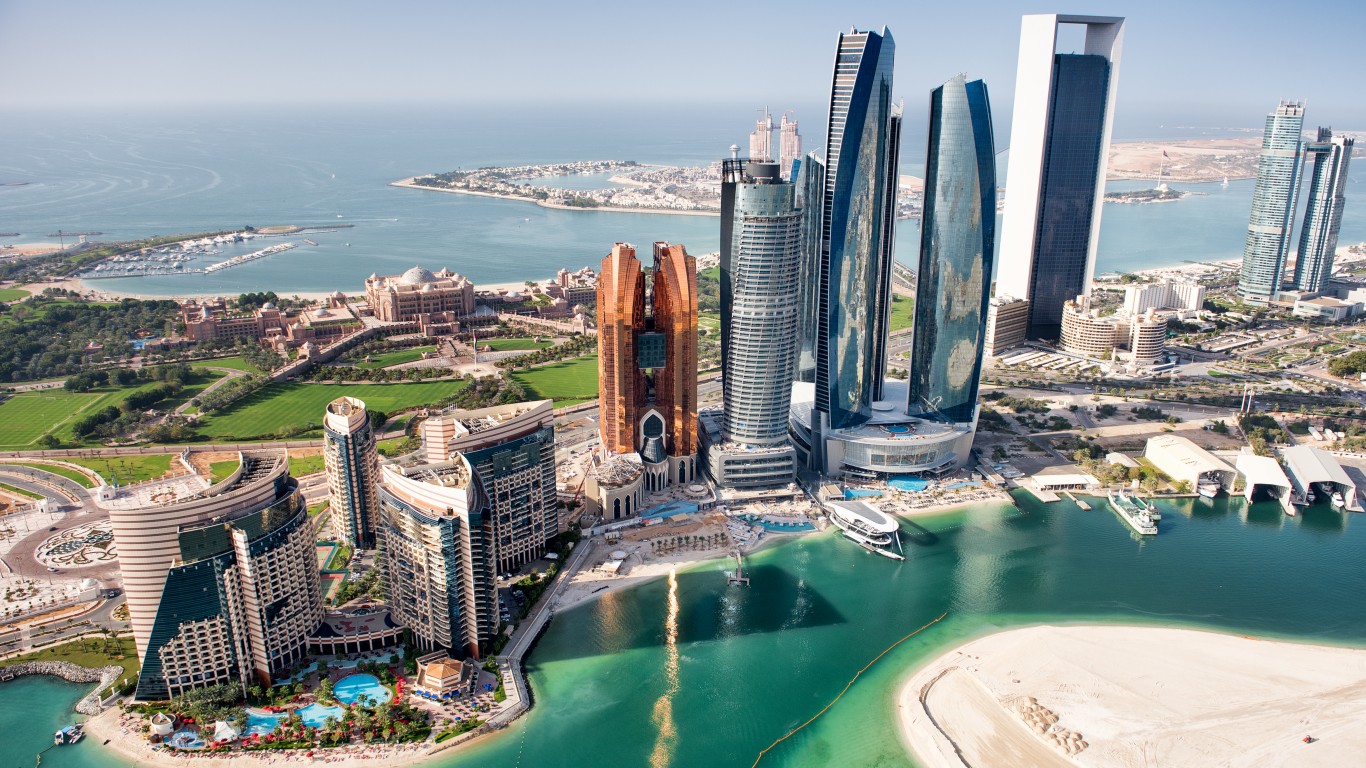
7. United Arab Emirates
> GNI per capita: $67,758
> 2017 GDP: $632.6 billion (31st out of 196 countries)
> Population: 9.4 million
> Life expectancy at birth: 77.4 years
Nearly half of all exports from the United Arab Emirates are forms of petroleum — crude, refined, or gas. The country’s exports also include precious metals and minerals like gold and diamonds. These valuable exports have helped make the UAE one of the wealthiest countries in the world, with a GNI per capita of $67,758.
The UAE has among the highest rates of primary school enrollment and primary school completion, setting up students for future success. The country also has one of the lowest unemployment rates in the world, at 2.6%, just over half of the 5.0% worldwide unemployment rate.
[in-text-ad-2]

6. Bermuda
> GNI per capita: $68,113
> 2017 GDP: $3.3 billion (169th out of 196 countries)
> Population: 65,441
> Life expectancy at birth: 81.4 years
The island nation of Bermuda is by far the least populous country to rank among the richest in the world, with a population of less than 66,000. Bermuda’s exports are worth very little. The nation ranks among the wealthiest largely because of international businesses, like insurance and financial services companies that operate in the country. These businesses account for around 85% of Bermuda’s GDP. Tourism is also an economic boon for the country accounting for a large share of total employment.

5. Kuwait
> GNI per capita: $72,872
> 2017 GDP: $271.1 billion (57th out of 196 countries)
> Population: 4.1 million
> Life expectancy at birth: 74.8 years
Kuwait is one of just five nations with a GNI per capita above $70,000. Unlike most other countries that rank among the wealthiest in the world, Kuwait does not have a diverse economy. Petroleum accounts for more than 84% of its exports. Kuwait ranks as one of the most corrupt nations on this list, likely resulting in an uneven dispersal of the wealth created from petroleum.
Along with fellow oil-rich nation Saudi Arabia, Kuwait is one of the only countries that rank among the richest in the world that saw a decline in their GDP in 2017. Kuwait actually had one of the sharpest decreases in GDP of any country, with an economic contraction of 2.9%.
[in-text-ad]

4. Brunei
> GNI per capita: $76,427
> 2017 GDP: $30.8 billion (125th out of 196 countries)
> Population: 428,697
> Life expectancy at birth: 77.4 years
Petroleum accounted for more than 90% of Brunei’s exports in 2017. As a result of its wealth of valuable resources, the relatively small Southeast Asian nation has become one of the world’s wealthiest, with a GNI per capita in excess of $76,000. Citizens of the country do not have to pay taxes and still enjoy generous services provided by the public sector.
The country is not without its economic and social problems however. Operating under sharia law, citizens can be stoned for adultery and have a limb amputated for crimes like theft. Brunei also has the highest unemployment rate among the 25 richest countries at 9.2%. Worldwide, the unemployment rate is less than 5%.

3. Singapore
> GNI per capita: $82,503
> 2017 GDP: $480.0 billion (39th out of 196 countries)
> Population: 5.6 million
> Life expectancy at birth: 82.9 years
Sitting on the southern edge of Malaysia, Singapore is an important shipping point, connecting much of mainland Asia to the rest of the world. Singapore’s economy, which has a GNI per capita of $82,503, is one of the most business-friendly in the world due in part to a lack of cumbersome regulations.
Singapore is the single largest seller of integrated circuits, or microchips, in the world. These circuits makes up 36% of Singapore’s exports. As it relies heavily on the export of technology, Singapore invests a large amount, worth 2.2% of the nation’s GDP, in research and development.

2. Macao SAR, China
> GNI per capita: $95,304
> 2017 GDP: $65.3 billion (98th out of 196 countries)
> Population: 0.6 million
> Life expectancy at birth: 84.0 years
Macao is another special administrative region of China, meaning it is not fully autonomous, as China handles foreign affairs and defense. Since allowing the foreign competition in its local casino industry starting in 2001, Macao has become one of the world’s top gaming destinations, and the sector has pumped billions of dollars into the economy of this relatively small region. Only one nation has a higher GNI per capita than Macao’s $95,000.
Macao’s economy is growing faster than that of any country that ranks among the 25 richest in the world. The special administrative region’s economy grew 9.1% in 2017, nearly triple the rate of the worldwide GDP growth.
[in-text-ad-2]

1. Qatar
> GNI per capita: $116,799
> 2017 GDP: $308.6 billion (51st out of 196 countries)
> Population: 2.6 million
> Life expectancy at birth: 78.3 years
Qatar is, by far, the richest country in the world, with a GNI per capita of $116,799 — more than $20,000 higher than any other nation. The country has more in oil reserves than all but two other countries worldwide — equal to 13% of the global supply. This natural resource brings in tens of billions of dollars to the country of less than 3 million residents each year. Oil revenue helps subsidize government services in the country. Petroleum accounts for nearly all of Qatar’s exports — 87%.
Thanks to its strong economy, Qatar’s unemployment rate is one of the lowest in the world, at 0.2%.
Methodology
To identify the richest countries in the world, 24/7 Wall St. reviewed the gross national income (GNI) per capita for 2017 from the World Bank’s “World Development Indicators Database.” GNI is in constant 2011 international dollars. Additional data on GDP, total population, and life expectancy for the most recent years available is also from the World Bank database. The Corruption Perceptions Index score for 2018 comes from the Transparency International CPI.
Take Charge of Your Retirement In Just A Few Minutes (Sponsor)
Retirement planning doesn’t have to feel overwhelming. The key is finding expert guidance—and SmartAsset’s simple quiz makes it easier than ever for you to connect with a vetted financial advisor.
Here’s how it works:
- Answer a Few Simple Questions. Tell us a bit about your goals and preferences—it only takes a few minutes!
- Get Matched with Vetted Advisors Our smart tool matches you with up to three pre-screened, vetted advisors who serve your area and are held to a fiduciary standard to act in your best interests. Click here to begin
- Choose Your Fit Review their profiles, schedule an introductory call (or meet in person), and select the advisor who feel is right for you.
Why wait? Start building the retirement you’ve always dreamed of. Click here to get started today!
Thank you for reading! Have some feedback for us?
Contact the 24/7 Wall St. editorial team.
 24/7 Wall St.
24/7 Wall St. 24/7 Wall St.
24/7 Wall St. 24/7 Wall St.
24/7 Wall St.


